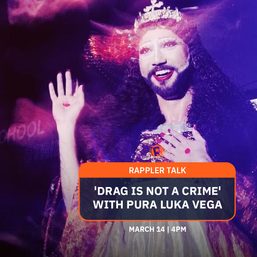SUMMARY
This is AI generated summarization, which may have errors. For context, always refer to the full article.

CEBU, Philippines – Isolated in the mountains of Barangay Pamutan in Cebu City is the Hearts of Jesus and Mary Seminary of the Marian Corps of Saint Pius X (MCSPX). The seminary is perched on a valley. It used to be made of bamboo, but the structure was destroyed by Typhoon Odette (Rai) in 2021. The building, which is still unfinished, now has a steel frame.
To get to the seminary from the city center, one needs to drive for an hour, in some parts over bad and dangerous roads. There are two parking spots that are makeshift laybys on roadsides in the middle of nowhere. The closest one from the city requires a longer walk, the other offers a shorter hike but at such steep dirt paths that are impassable when it rains.
It took us close to an hour to walk to the seminary from our parking spot. Alejandro, a 22-year-old who looks 14, accompanied me. Alejandro, who requested to be identified only by his first name, was a student at the Hearts of Jesus and Mary Seminary in 2020. He stayed a year. The vocation wasn’t for him, he said.

Alejandro attends traditional Latin Masses (TLM) or Tridentine Masses in churches that hold them in Cebu. He is part of a growing global trend, especially in the United States, of young people returning to church traditions such as the TLM.
In the TLM, the priest says the entire Mass in Latin, not in the vernacular. The priest also faces East, toward the altar, not the people. The TLM was the way the Mass was said from the late 1500s until the late 1960s, when a historic meeting of bishops in Rome – the Second Vatican Council or Vatican II – allowed the Mass to be said in local languages to ensure “full and active participation” of the faithful.
The Archdiocese of Cebu authorizes only one service – every Sunday at 1 pm in the Chapel of Holy Relics, Tabor Hill in Barangay San Jose, Cebu City. It is run by the Order of the Discalced Augustinians (OAD). Only three priests are authorized by the archdiocese to celebrate the Latin Mass. Because of their small number, there have been Sundays with no Latin Masses. The regulations are in keeping with restrictions imposed by Pope Francis in his 2021 motu proprio, Traditiones Custodes.
Another church that holds Latin Masses is the Saint Pius V Chapel of the Society of Saint Pius X (SSPX) in Barangay Umapad, Mandaue City. The SSPX was founded by the late Archbishop Marcel Lefebvre, who was excommunicated along with the four bishops he consecrated in 1988 despite the prohibition by Pope John Paul II. That excommunication was lifted by Pope Benedict XVI in 2009.
The SSPX “does not have a canonical status” and its ministers “do not legitimately exercise any ministry in the Church,” Pope Benedict XVI wrote in 2009.
When the order tried to repair relations with Rome, some of its priests disagreed with the move. They were kicked out. Among them was Father François Chazal. There is still a video on YouTube of Father Chazal, barred from celebrating Mass at an SSPX chapel in Quezon City, saying Mass on the street in 2012.
Father Chazal said in an interview with Rappler that it wasn’t yet time for the SSPX to reconcile with the Vatican “because we have to wait until (Pope) Francis converts before we do a reconciliation and have a canonical agreement with him. Because it is actually his situation that is irregular, whereas we haven’t contracted any irregularity by keeping the faith. So that’s why there was a split that happened in 2012.”
The openness to reconciling with the Vatican is what divides the SSPX and the MCSPX. The MCSPX accuses SSPX of betraying Lefebvre and working to reconcile with Rome. The MCSPX said it will only reconcile with Rome when “returns to tradition” and renounces the “heresy” of Vatican II.
That “crisis” led to the formation of the MCSPX, Father Chazal said.
The core tenets of the MCSPX dogma are its call for a “return to tradition” and rejection of Vatican II and its reform of the Mass. They only celebrate the pre-Vatican II Tridentine mass.
While the MCSPX accepts Pope Francis as the leader of the Catholic Church, it considers him a heretic and does not follow what it deems as his heretical actions, such as his openness to deal with the LGBTQ community.
MCSPX also rejects the call for ecumenism and considers the Catholic Church as the only true faith.
“We remain until our last breath, the children, the sons of Saint Pius X,” Father Chazal proclaims at the opening of every YouTube video that MCSPX publishes. Pope Pius X is known for liturgical reforms and being anti-modernist.

During his sermons, Father Chazal often brands Pope Francis a heretic and expresses support for Archbishop Carlo Maria Viganò, who is on trial at the Vatican for schism.
He said the phrase Catholic resistance is the common albeit “imperfect name” to describe them.
“We are just staying Catholic. But it’s called the resistance,” Father Chazal said. “Against overwhelming odds.”
Last Saturday, June 29, Father Chazal led the “Taking of the Cassock” ceremony at their remote seminary. It marked the first part of a candidate’s journey to the priesthood.
“This cassock covers the entire body and it signifies a change of life. It signifies a life which is turning towards God,” Father Chazal said during the ceremony. “It is cutting off from the world.”
Father Chazal then put on the white cassock and red sash on first-year seminarians Josiah Loeman from New Zealand and Filipino-Australian Joseph Emmanuel Thomas Mateo. The seminary currently has three students. Father Chazal expects two more seminarians later in the year, from Ireland and France.
He said in one of his talks that he had to reject many seminary candidates from the Philippines because of “effeminacy.” He said a major problem in the country is that the young people are in “electronic cages” of mobile phones.
During his sermon, Father Chazal bemoaned the non-wearing of cassocks by priests in the Philippines. The white cassock and red sash of the MCSPX priests and seminarians make them stand out in crowds when they go to mission areas.
There are three MCSPX priests based in Cebu administering to 40 small groups throughout the Visayas and Mindanao. Cebu is the base for what Father Chazal calls the “rebuilding of the faith.” They also do missions in Korea, Malaysia, and Japan.
The day after the ceremony, Father Chazal was up early and out the whole day to celebrate three Tridentine masses, taking the order’s small multicab to Pardo, Cebu City in the morning, Lapu-Lapu City at noon, and the southern town of Dalaguete in the evening.
I attended the one in the Our Lady Help of Christian Chapel in Barangay Buaya in Lapu-Lapu City. The chapel, constructed during the COVID-19 pandemic lockdown, is in the middle of an urban poor community near the barangay hall. To get there, you ask people for directions to the “pari nga puwa ang bakus” (priests with red belts). I passed by the barangay gym, which was holding a praise and prayer service with rock and roll that Sunday.
The MCSPX chapel was full. Seating was segregated with women on the left and men on the right. That day, the faithful from Liloan and Danao City attended the Lapu-Lapu service.
At times, the noise of airplanes taking off would drown out the Latin service for a few seconds. Last Sunday, it was during the Symbolum Nicaenum or Nicene Creed.
The chapel is still unfinished and looks makeshift. Father Chazal had to arrange for more construction work after the mass.
Among those who attended the service was Erik Monisit from Liloan. He used to be a lay missionary for the Book of Truth and Divine Mercy groups of the mainstream Catholic Church.
He started questioning his faith when he was given a book on church history. He said he realized that the church was “infiltrated by Masons during Vatican II” and that the Novus Ordo Mass – or the post-Vatican II liturgy – was “a Protestant Mass.”
He talked to his wife, who searched online for traditional groups in Cebu. That was how they found their way to the SSPX chapel in Mandaue City. They followed Father Chazal when he was kicked out.

Father Chazal is a persecuted martyr, Karen Cajes told Rappler after the Mass. She recounted how she studied for three years to be a nun at the SSPX convent before leaving and then marrying Reynaldo Cajes, who left the choir of the Parish of Virgen dela Regla in Lapu-Lapu City.
The couple has five children. “Lima pa,” (five for now) said Reynaldo. They tell me the average number of children among their faithful is 12.
Karen expressed surprise when I failed to recognize her Saint Benedict medal and asked about it.
“So, wala diay ka kaila aning mga sacramentals?” (You don’t recognize these sacramentals?) she said with a hint of disapproval.
When I dithered on my answer, she asked me, “Gikan ka sa lahing tinuohan?” (Are you from another faith?)
“Searching diay ka?” (Are you searching?) Karen pressed me. She ended our interview by quoting Aquinas, “Matud pa ni (According to) Saint Thomas Aquinas, for those who have faith, no explanation is needed.” – Rappler.com
Add a comment
How does this make you feel?




![[The Wide Shot] The public stoning of Boy Dila](https://www.rappler.com/tachyon/2024/07/TL-boy-dila-july-6-2024.jpg?resize=257%2C257&crop=271px%2C1px%2C721px%2C719px)












There are no comments yet. Add your comment to start the conversation.